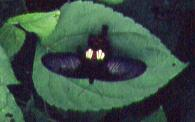This week's butterfly may be a critically endangered species, or it may be a rare mutation of another species. The Internet displays plenty of hits for Atrophaneura leytensis or Pachliopta leytensis, and most of them are either lists or questions about whether leytensis is really a distinct species at all. Some of the lists are lists of endangered species that may not be imported into other countries than the Philippines. The butterfly is certainly rare and obscure. Few people are claiming to have seen or photographed one. If, however, it is a variant form of Pachliopta phegeus, it's also found on Mindanao, Cebu, and some other islands, and is not rare or obviously threatened at all. The IUCN Red Book admits that leytensis may belong to the same species as phegeus. Not all scientists agree:
Here's one of very few pictures said to be of a living leytensis, rather than a museum specimen.
In flight, the peculiar way the Roses can hold their hind wings, and the darker shading on the inner part of the upper wings, can give this swallowtail an odd, un-swallowtail-like silhouette when viewed at some angles:
The body is dark above, with red visible sometimes on the head and sometimes only on the tail tip, almost like a firefly.
Several of the Roses look similar to this, but species show consistent, though subtle, differences in the size and shape of the white spot on the hind wing. Christian Schulze has published a detailed illustrated guide to classifying the butterflies by their spots. The butterflies themselves probably use scent to help them recognize the spots of potential mates as distinct from similar species with which they can't mate.
Leytensis means "of Leyte island" in the Philippine archipelago. The Rose Swallowtails, now known as the genus Pachliopta, aren't the only group of living things that includes a species thought to be peculiarly found on this island. Leyte is also believed to have its own particular species of turtle and of some plants.
Pachliopta leytensis caterpillars are known to eat only one food plant, Aristolochia philippensis. Whether they can survive on any other food is not known.



No comments:
Post a Comment